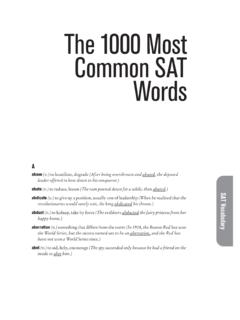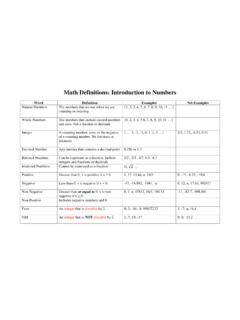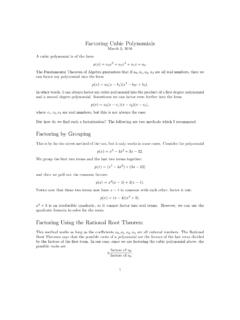Transcription of Lesson 8: Bell Curves and Standard Deviation
1 Hart Interactive Algebra 1 M1 Lesson 8 ALGEBRA I Lesson 8: Bell Curves and Standard Deviation Opening Reading 1. Read over the description of a bell curve and then mark the picture with the characteristics of the curve. Which characteristic was confusing for you? [source: ] Lesson 8: Bell Curves and Standard Deviation Unit 1: Measuring Distributions 2014 Common Core, Inc. Some rights reserved. This work is licensed under a Creative Commons Attribution-NonCommercial-ShareAlike Unported License. Hart Interactive Algebra 1 M1 Lesson 8 ALGEBRA I Youtube video on bell curve and SD at Bell Curve Probabability and Standard Deviation To understand the probability factors of a normal distribution you need to understand the following rules : 1.
2 The total area under the curve is equal to 1 (100%). 2. About 68% of the area under the Curves falls within 1 Standard Deviation . 3. About 95% of the area under the curve falls within 2 Standard deviations. 4. About of the area under the curve falls within 3 Standard deviations. Items 2, 3 and 4 are sometimes referred to as the empirical rule of the rule. [source: ] 2. A. If 200 people were in the data set above, about how many would you expect to be within 1 Standard Deviation of the mean? B. The Standard Deviation for men is about 3 inches.
3 Label the graph above right with the heights of men at each Standard Deviation marking. Lesson 8: Bell Curves and Standard Deviation Unit 1: Measuring Distributions 2014 Common Core, Inc. Some rights reserved. This work is licensed under a Creative Commons Attribution-NonCommercial-ShareAlike Unported License. Hart Interactive Algebra 1 M1 Lesson 8 ALGEBRA I 3. We ve used the term Standard Deviation several times in the Opening Reading, but what does Standard Deviation mean? What the YouTube video How to Calculate Standard Deviation at Answer the questions below as you watch the video.
4 A. What does Standard Deviation tell us about the data? B. Complete the steps for finding the Standard Deviation . First, find the _____ of the data set. This is symbolized by _____. The second step is to _____ the mean from each data point. The third step is to _____ each _____. This makes the _____ positive so they don t _____ each other out. The fourth step is to _____ the _____ of the _____. The final step is to take the _____ _____. This counteracts the _____ we did earlier. C. When do you divide by n and when do you divide by n 1 in the fourth step?
5 Lesson 8: Bell Curves and Standard Deviation Unit 1: Measuring Distributions 2014 Common Core, Inc. Some rights reserved. This work is licensed under a Creative Commons Attribution-NonCommercial-ShareAlike Unported License. Hart Interactive Algebra 1 M1 Lesson 8 ALGEBRA I Exploratory Challenge 1 Finding the Standard Deviation You will need: the Lesson 1 data from Station 8 Test Your Memory WQI versus MOP handout You ll be completing the table on the handout with the data from the Test Your Memory station.
6 We are going to follow a multi-step process to calculate the Standard Deviation , which will help us measure how spread out the values are. Only the first row of each table is filled in with your class data. 4. First we ll look at the shape of the data using a dot plot. Create dot plots for each set of data (real words versus non- words ) in the space at the below. 5. Do the number of 3-letter words differ more when the letters are random or when they form a word in English? Explain your thinking. 6. Did either graph form a bell curve? Why do you think this happened?
7 Lesson 8: Bell Curves and Standard Deviation Unit 1: Measuring Distributions 2014 Common Core, Inc. Some rights reserved. This work is licensed under a Creative Commons Attribution-NonCommercial-ShareAlike Unported License. Hart Interactive Algebra 1 M1 Lesson 8 ALGEBRA I 7. Even if the data did not form a bell curve, we ll use it to find the Standard Deviation of each set of data. Complete the steps below. Calculate the mean of each data set. B. Calculate the deviations from the mean (actual value minus the mean) for the remaining values, and write your answers in the appropriate places in the table.
8 Remember the mean for the words and the mean for the non- words are probably not the same. C. Square the deviations from the mean for each data set. D. Add up the squared deviations. This result is the sum of the squared deviations. For the words : _____ For the non- words : _____ E. The number of values in the data set is denoted by . You divide the sum of the squared deviations by 1. For the words : _____ For the non- words : _____ F. Finally, you take the square root of the value you found in Part E. Units for Standard Deviation are the same as the units for the data set (number of words , in this case).
9 What does this answer mean? For the words : _____ For the non- words : _____ 8. Which set of data had the greatest Standard Deviation ? How can you see this in the graph? 9. Mark off the mean, 1 Standard Deviation , 2 Standard deviations, and e Standard deviations on the graph. Does this follow the rule? Lesson 8: Bell Curves and Standard Deviation Unit 1: Measuring Distributions 2014 Common Core, Inc. Some rights reserved. This work is licensed under a Creative Commons Attribution-NonCommercial-ShareAlike Unported License. Hart Interactive Algebra 1 M1 Lesson 8 ALGEBRA I Lesson Summary Bell Curve Standard Deviation The formula for the Standard Deviation : Description of the Standard Deviation steps: is a value from the original data set; is a Deviation of the value, , from the mean, ; ( )2 is a squared Deviation from the mean; ( )2 is the sum of the squared deviations; ( )2 1 is the result of dividing the sum of the squared deviations by 1.
10 So, ( )2 1 is the Standard Deviation . [source: ] Lesson 8: Bell Curves and Standard Deviation Unit 1: Measuring Distributions 2014 Common Core, Inc. Some rights reserved. This work is licensed under a Creative Commons Attribution-NonCommercial-ShareAlike Unported License. Hart Interactive Algebra 1 M1 Lesson 8 ALGEBRA I Homework Problem Set 1. Ten members of a high school girls basketball team were asked how many hours they studied in a typical week. Their responses (in hours) were 20, 13, 10, 6, 13, 10, 13, 11, 11, 10.







